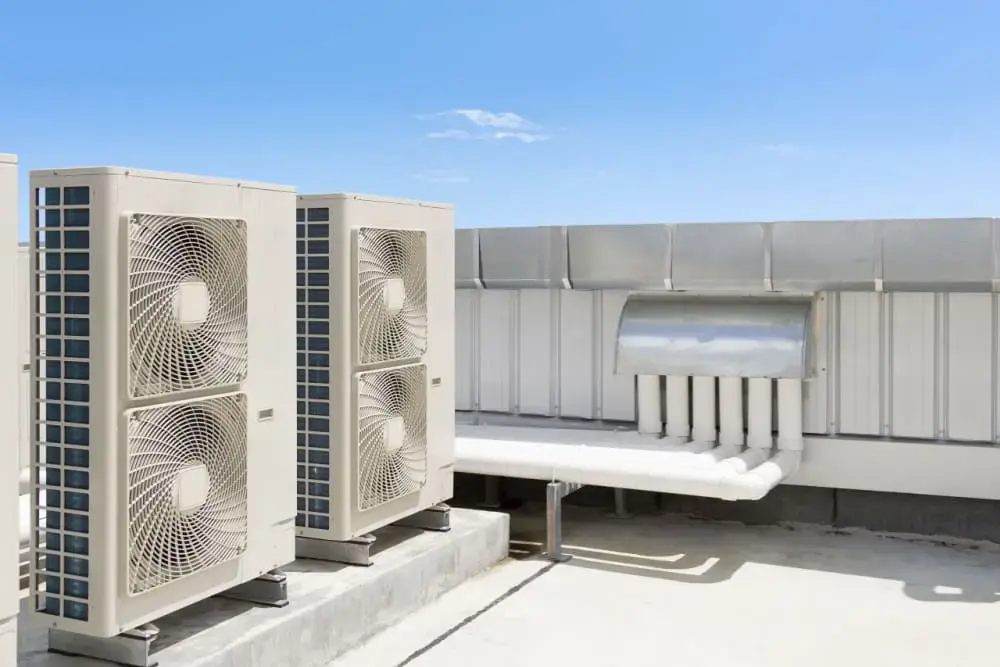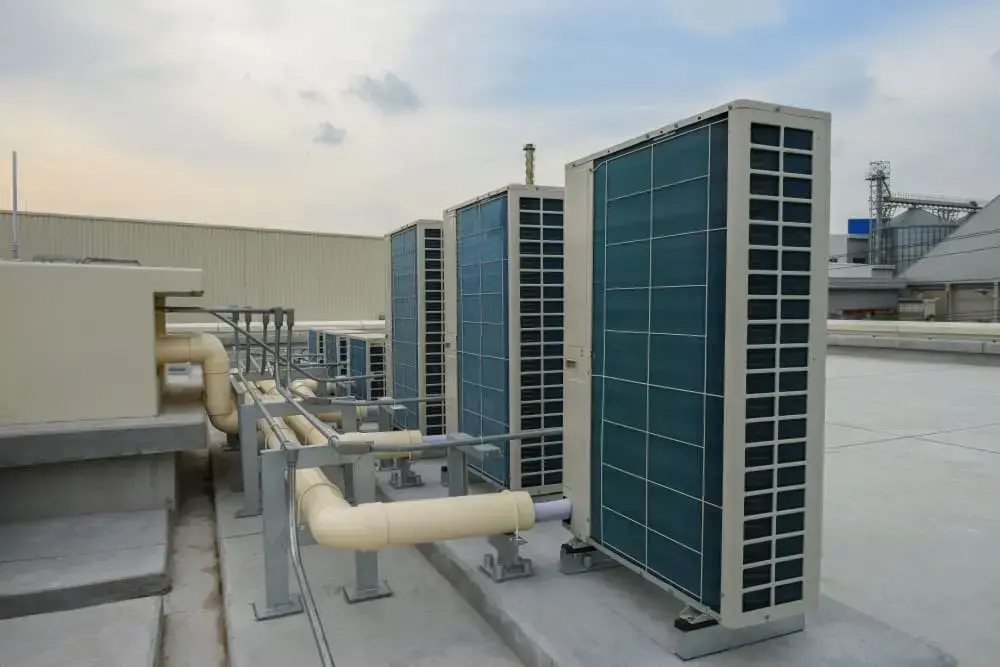
Variable Refrigerant Flow Systems
Variable refrigerant flow (VRF) systems are among the most energy-efficient HVAC solutions in the market, and they provide both space heating and air conditioning.
Flexible
Consolidate space heating and air conditioning into a single installation.
Energy Efficient
Reduce your energy expenses while improving temperature control.
Green
Replace combustion heaters with a technology that only uses electricity.
Variable Refrigerant Flow Systems
Variable refrigerant flow (VRF), also known as variable refrigerant volume (VRV), is an HVAC technology that was invented in Japan in the 1980s. VRF systems are characterized by their superior energy efficiency and their flexible output according to load. Savings of over 60% are often achieved when VRF systems replace conventional air conditioners, and they can compete with the cost of natural gas heating without the associated emissions.
Our HVAC engineers can inspect your property to carry out a detailed calculation of heating and cooling loads and to design and specify a VRF system that suits your needs. We also offer VRF design for new construction projects, helping you achieve top HVAC performance from the first day of building operation.


Variable refrigerant flow (VRF), also known as variable refrigerant volume (VRV), is an HVAC technology that was invented in Japan in the 1980s. VRF systems are characterized by their superior energy efficiency and their flexible output according to load. Savings of over 60% are often achieved when VRF systems replace conventional air conditioners, and they can compete with the cost of natural gas heating without the associated emissions.
Our HVAC engineers can inspect your property to carry out a detailed calculation of heating and cooling loads and to design and specify a VRF system that suits your needs. We also offer VRF design for new construction projects, helping you achieve top HVAC performance from the first day of building operation.
How Does a Variable Refrigerant Flow System Work?

Variable refrigerant flow systemsare characterized by using refrigerant lines directly to move heat, similar to how a mini-split air conditioner works. Unlike other HVAC configurations, VRF systems do not use air ducts or hydronic piping, which saves plenty of space.
Typically, a VRF system has a large outdoor unit connected to several indoor units with refrigerant lines. The outdoor unit has one or more variable speed condensers, adjusting its output according to the total heating or cooling demand of indoor units. This configuration is much more efficient than using an ON/OFF control to run the condenser intermittently, and equipment lasts longer by avoiding the mechanical wear of frequent starts and stops
VRF systems are normally designed to operate as heat pumps, allowing reversible operation between heating and cooling modes. Some VRF designs are designed for cooling only, but they are better suited for tropical weather; their usefulness is limited when a building requires both air conditioning and space heating during the year.
Benefits of Using a Variable Refrigerant Flow System
Many property owners deploy VRF systems to take advantage of their superior energy efficiency, especially if their building is located in a state with electricity rates above the national average. As mentioned above, VRF systems also offer flexible operation, adjusting their output to match the building load and keeping comfortable temperatures throughout the entire year.
Enhanced comfort and health are also among the benefits of VRF systems. Their operation is very silent because they use refrigerant lines instead of air ducts, and they isolate air pollutants and unpleasant odors because each building area is served independently.
Another advantage of VRF systems is their reduced space requirement, replacing bulky air ducts and hydronic piping with more compact refrigerant lines. This can be a significant advantage in large commercial buildings, where many MEP components are often installed in the reduced space above the ceiling.
VRF systems also have the potential to reduce carbon emissions from the building sector, since they can replace combustion-based space heating with a technology that only consumes electricity. Resistance heating is not competitive due to its high cost, but VRF systems can operate efficiently in both cooling and heating mode.
VRF System Comparison: Two-Pipe and Three-Pipe Configurations
Variable refrigerant flow systems are available in two-pipe and three-pipe configurations, and each option offers different performance features.
Two-pipe VRF systems only have a supply line and a return line between the outdoor unit and the multiple indoor units. This layout is simpler and less expensive than a three-pipe configuration, but it also comes with a limitation: the system cannot deliver simultaneous heating and cooling for different buildings, and all indoor units must operate in the same mode.
Some manufacturers have developed devices called branch controllers, which allow simultaneous heating and cooling with a two-pipe VRF system. Basically, a branch controller uses the heat removed by units in cooling mode and delivers it to areas that require heating. The outdoor unit only provides balance between heating and cooling loads.
Three-pipe VRF systems have two supply lines, one for heating and one for cooling, and a common return line. Indoor units are connected to all three refrigerant lines, and they have a branch selector that switches between the heating and cooling lines as needed.
Like in most engineering decisions, each option has advantages and disadvantages, and the best selection depends on project conditions:
- Two-pipe VRF systems with branch controllers offer the most flexible configuration for future expansions. All refrigerant lines are connected to a common hub, and you can simply add more as required by new indoor units.
- On the other hand, three-pipe VRF systems offer a higher energy efficiency. However, they are less flexible for future expansions, since you have to modify the existing refrigerant lines.
Implementing Variable Refrigerant Flow Systems Successfully
Although VRF systems have been used in in Japan since the 1980s, they are a relatively new technology in the US. A qualified and experienced contractor can install a VRF system with ease, but the procedure can be challenging for contractors who have little experience with them. It is also important to note that VRF systems require a separate ventilation design, since they do not have built-in air ducts.
Like with any HVAC project, installation is simpler when design documents provide clear requirements and specifications. By working with professional HVAC engineers during the project design phase, you can avoid misunderstandings and changes during installation. In addition, you can also get your VRF system design approved without hurdles by local authorities.
VRF systems are highly efficient and provide long-term energy savings, but this quality comes with a higher upfront cost than conventional HVAC system. The design phase provides an excellent opportunity to optimize the VRF system layout and equipment capacity, reducing the total cost of the installation. In general, mechanical equipment achieves its top performance when sized optimally for the application; undersized and oversized systems bring performance issues, and with oversized installations you are spending more than necessary.
High-efficiency HVAC solutions can greatly improve your building performance, especially if you also have an efficient building envelope. While a VRF system provides heating and cooling with a low operating cost, a well-insulated and airtight building envelope minimizes these loads in the first place.
